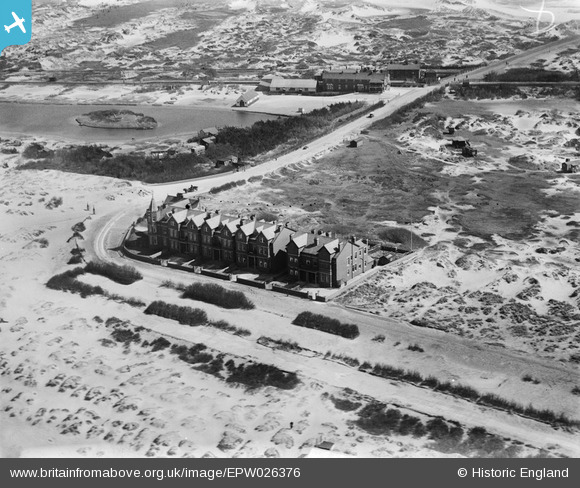epw026376 ENGLAND (1929). Ainsdale Beach Railway Station and sand dunes, Ainsdale-on-Sea, 1929
© Copyright OpenStreetMap contributors and licensed by the OpenStreetMap Foundation. 2025. Cartography is licensed as CC BY-SA.
Details
| Title | [EPW026376] Ainsdale Beach Railway Station and sand dunes, Ainsdale-on-Sea, 1929 |
| Reference | EPW026376 |
| Date | April-1929 |
| Link | |
| Place name | AINSDALE-ON-SEA |
| Parish | |
| District | |
| Country | ENGLAND |
| Easting / Northing | 329878, 412780 |
| Longitude / Latitude | -3.059909996192, 53.606642793442 |
| National Grid Reference | SD299128 |
Pins
 tony |
Wednesday 5th of October 2016 04:00:18 PM | |
 Class31 |
Tuesday 23rd of October 2012 11:37:02 PM | |
 Class31 |
Tuesday 23rd of October 2012 11:36:15 PM | |
 Class31 |
Tuesday 23rd of October 2012 11:35:09 PM | |
Cheshire Lines Railway GC / LNER not LMS |
 Bryan |
Saturday 22nd of February 2014 08:22:57 PM |
Ownership of the CLC was complex. Initially a partnership rather than a railway company (although it referred to itself as such) between Great Northern Railway (GNR) and the Manchester, Sheffield and Lincolnshire Railway (MS&LR). A later partner was Midland Railway (MR). When CLC became an independent company it had directors from each of the three constituent companies. 1923: Partner MR (with LNWR) became LMS MS&LR had become Great Central railway and went to LNER as did GNR. Strictly the line was neither LMS nor LNER but joint owned by both companies until 1948 when it became a part of the London Midland Region of British Railways being treated as an English LMS line. |
 totoro |
Saturday 22nd of February 2014 10:17:57 PM |
The Southport & Cheshire Lines Extension Railway (SCLER) opened this station on 9 June 1901. It was named Seaside from its opening until 1 January 1912 when it was renamed Ainsdale Beach. The station was built adjacent to a hotel called The Lakeside Hotel (now named 'The Sands' and trading as a local pub) Original company: Cheshire Lines Committee Closed January 1917, but reopened 1st April 1919. Neither LMS nor LNER - see separate note re CLC - but in 1948 was treated as though it was an English line of LMS and went to the London Midland Region of BR.. Closed again January 1952. |
 totoro |
Saturday 22nd of February 2014 10:22:26 PM |
 Class31 |
Tuesday 23rd of October 2012 11:34:01 PM | |
 Class31 |
Tuesday 23rd of October 2012 11:31:41 PM | |
 Class31 |
Tuesday 23rd of October 2012 11:31:08 PM | |
The signal box was opened on the 16th December 1900, shortly after the station had opened, and was initially named "Seaside". It was a Cheshire Lines Type 1 signal box of all wood construction and contained a 16 lever Cheshire Lines lever frame and level crossing gate wheel. It replaced an earlier signal box named "Sandhills", which had been about 500 yards further North. Seaside signal box was renamed Ainsdale Beach on the 1st January 1912 and closed on the 7th July 1952 when goods services ceased. |
 Jutland |
Friday 1st of August 2014 02:35:35 PM |
User Comment Contributions
As described re this joint railway post 1923, the CLC was, until 1948 two thirds owned by the LNER and one third by the LMS. The railway's HQ was located at Liverpool Central Station until nationalisation (this was the old high level station now demolished) The HQ was located there so to control the logistics and the great revenues earned through movements of goods and raw materials to and from the port. The busiest passenger traffic was, of course, between Liverpool and Manchester Central stations. Unfortunately, the Southport and Cheshire Lines Extension Railway was loss making almost from the outset and could only rely upon seasonal excursion traffic with infrequent daily scheduled services mainly sourced from Manchester and suburban stations on the North Liverpool Loop Line.Most Liverpool people used the direct ex LYR (LMS)service from Liverpool Exchange to Southport Chapel Street. The SCLER stations between Southport and Aintree were mainly positioned in sparsely populated rural areas and miles away from what population was to hand. Passenger services ceased on the 5th January 1952,nearly a decade before the Beeching Axe was wielded elsewhere. |
 Davy |
Wednesday 15th of July 2015 08:35:40 PM |


![[EPW026376] Ainsdale Beach Railway Station and sand dunes, Ainsdale-on-Sea, 1929](http://britainfromabove.org.uk/sites/all/libraries/aerofilms-images/public/100x100/EPW/026/EPW026376.jpg)
![[EPW026375] Ainsdale Hills sand dunes, Ainsdale-on-Sea, 1929](http://britainfromabove.org.uk/sites/all/libraries/aerofilms-images/public/100x100/EPW/026/EPW026375.jpg)
![[EPW058496] The boating lake and seafront, Ainsdale-on-Sea, 1938](http://britainfromabove.org.uk/sites/all/libraries/aerofilms-images/public/100x100/EPW/058/EPW058496.jpg)
![[EPW058493] Ainsdale and Birkdale Sands, Ainsdale-on-Sea, from the south-west, 1938](http://britainfromabove.org.uk/sites/all/libraries/aerofilms-images/public/100x100/EPW/058/EPW058493.jpg)